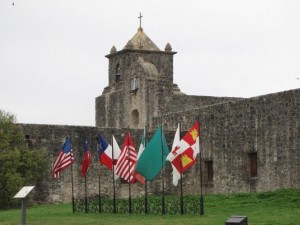First Republic Of Texas Born 199 Years Ago
An historic event occurred 199 years ago this week at San Antonio de Bexar that is still ignored in history textbooks and the media at large. On April 6, 1813, Jose Bernardo Gutierrez de Lara issued the first ever Declaration of Independence against Spainin North America. Contrary to popular myth, Rev. Miguel Hidalgo y Costilla considered the “Father of Mexican Independence” opposed independence from Spainand thus never issued such a declaration. The Hidalgouprising initiated September 16, 1810proclaimed loyalty to King Fernando VII as documented in the original Grito de Dolores.
“Viva Fernando VII, Viva America, Viva La Religion” made it clear that Hidalgo and his followers were loyal to the Spanish Crown, the Roman Catholic Church and to the idea that the American Continent born Spanish citizens could govern themselves and remain an integral part of the Spanish Empire.
Gutierrez de Lara who had supposedly met with Rev. Hidalgo took it upon myself to seekU. S.aid and traveled to Washington D.C. He was directed to seek assistance fromU. S.Consul official William Shaler atNew Orleans,Louisiana. He was not told that Shaler was the head of U. S. Secret Service. True to his assignment, Shaler raised financial support, volunteers, weapons, munitions and provisions for a force titled “The Republican Army of the North”. The rebel army composed of Tejanos and volunteers from Coahuila and Tamaulipas were led by Gutierrez de Lara. TheU. S.volunteers were headed by Augustus Magee. The ethnically mixed Republican Army of the North that included Native American volunteers, enteredTexasviaNacogdochesonAugust 12, 1812. The force proceeded to Goliad where they arrivedNovember 7, 1812. During the siege that followed, August Magee fell ill and died and Samuel Kemper took over theU. S.volunteers.
The Spanish forces abandoned Goliad and headed for San Antonio de Bexar. The rebel army delayed moving towards Bexar until March 1813. A battle ensued at a site called El Rosillo on the southeast corner of present Bexar onMarch 29, 1813. The Spanish royalists retreated to Bexar and surrendered the city ofBexar andprovince ofTexas to the rebels onApril 1, 1813. Two days later Spanish Governor Manuel de Salcedo and 14 of his officers were executed at the Rosillo battle site. Samuel Kemper was said to be so angered by the executions that he and some 100U. S. volunteers quit the army and returned toLouisiana. Reuben Ross assumed command of theU. S. volunteers.
OnApril 6, 1813, Jose Bernardo Gutierrez de Lara issued a written Declaration of Independence against “European Spain and all other foreign powers”. Followers of Rev. Hidalgo loyal to Spanish King Fernando VII as well as the U. S. Government, under cover agent William Shaler and theU. S.volunteers at Bexar were upset. Shaler began to plot the overthrow of Gutierrez de Lara and Jose Alvarez de Toledo was sent by the U. S. Government fromBaltimore,MarylandtoLouisiana. Notwithstanding the political unrest, the Republican Army defeated an invading Spanish force headed by Col. Ignacio Elizondo along the banks of the Alazan Creek at the present near west side of downtownSan Antonio. The victory did not placate the U. S. Government or its agent Shaler who pressed the removal of Gutierrez de Lara. OnAugust 1, 1813, Alvarez de Toledo assumed command of the rebel army and five days later Gutierrez de Lara left Bexar forNew Orleans.San Antonioborn rebel Colonel Miguel Menchaca did not trust Alvarez de Toledo and his feelings were shared by the Tejano, Tamaulipeco and Coahuilence rebels.
Alvarez de Toledo reacted by diving the army under ethnic lines and many of the Native American volunteers feeling ignored and unappreciated returned to their villages.
It was this ethnically divided Republican Army of the North under the leadership of Jose Alvarez de Toledo that battled the Spanish army of Brigadier General Joaquin de Arredondo on August 13, 1813. The first encountered occurred at a still unknown site known only as “El Encinal del Rio Medina” within presentAtascosaCounty. The fighting continued northward toward theMedinaRiver as the rebel army retreated towards Bexar. The running battle along both the Camino Real de Laredo and Camino Real delRio Grande, and variousMedinaRiver crossings and trails, became the largest battle with the greatest number of casualties inTexas history.
SurvivingU. S.volunteers, Tejano, Tamaulipeco and Coahuilence rebels managed to escape toLouisianawhere they joined the U. S. Army under Andrew Jackson and participated in the Battle of New Orleans against an invading British force. Jose Alvarez de Toledo returned toSpainwhere he was un-masked as a double agent and given a pension and reward for his outstanding contributions to the Spanish Crown.
Gutierrez de Lara returned toMexicoafter it gained its independence fromSpainin 1821 and served as first Governor of Tamaulipas.
Historically, Texasas well as Mexican historians and textbooks have ignored the participation, contribution, and significance of Jose Bernardo Maximiliano Gutierrez de Lara and the First Republic of Texas. Periodically someone finds a cannon ball, grape shots, a saber or a musket and claims to have discovered “the site of the battle at the MedinaRiver” without understanding it was a running battle with many sites of engagement north of Pleasantonand Poteet along the Caminos Real and trails leading to various MedinaRivercrossings. Nonetheless, every year for the last 20 odd years a group of history enthusiast meet at one of the engagement sites followed by a symposium at Pleasanton where various speakers discuss the Republican Army of the North, the First Republic of Texas, and the historic running battle that started at Los Encinos del Rio Medina. May we never forget and especially so as we approach the 200th anniversary of the First Republic of Texas.
Richard G. Santos is an international research historian and retired university professor who lives in Pearsall, Texas.
[Photo by Sally Mersinger]

